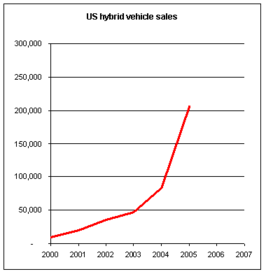 Hybrid cars are good for us, right? So policymakers should provide incentives — things like tax breaks, access to HOV lanes, and free parking for hybrid drivers.
Hybrid cars are good for us, right? So policymakers should provide incentives — things like tax breaks, access to HOV lanes, and free parking for hybrid drivers.
Well, not so fast, says a great article in today’s Washington Post. There’s growing reason to believe that those incentives for hybrids will make things worse — actually generating more gasoline use, not less. That’s because many of the incentives confuse the means for the end.
Reducing fuel use (and attendant GHG emissions, air pollution, etc.) is the goal; getting drivers into hybrids is simply one instrument in pursuit of that goal.
But one of the more popular incentives to boost fuel efficiency has been to encourage hybrid ownership by offering hybrid drivers access to HOV lanes, even when the drivers are alone. And as the article rightly points out:
An incentive — whether it’s access to a carpool lane or cut-rate financing — still aims to put another car on the road, and that undermines efforts to encourage carpooling.
Giving over HOV lanes to hybrids is probably counterproductive. In Virginia, where allowing hybrids in HOV lanes was pioneered, officials are worried that solo drivers in hybrids are clogging the high-capacity lanes and thereby discouraging carpools (because carpooling is no longer any faster than driving alone). In fact, 25 percent of all Virginia HOV lane users are hybrid drivers. And despite their hype, hybrids are not so fuel efficient that they can offset the fuel efficiency of an ordinary car with two or three riders. So the fuel efficiency of Virginia hybrids may become illusory as the vehicle fleet actually consumes more gas because drivers give up carpooling.
Same goes for other popular incentives: tax breaks and free or reduced-price parking. These incentives encourage people to drive by making it cheaper.
And if some incentives are wrong-headed, it’s because they seem to miss the reason why hybrids are good in the first place. If we want to reduce fuel use, it’s hard to see why hybrids deserve special tax breaks not afforded to buyers of other fuel-efficient, gas-powered cars (some of which are actually more efficient than certain hybrids). What’s so special about hybrids?
But wait! Incentives catalyze the market. That’s the basic argument for hybrid-centric policies. The idea is that by encouraging people to get into hybrids now, we’ll reduce fossil-fuel consumption down the road, when hybrid cars become cost-competitive.
There’s some merit to this line of reasoning, but it’s starting to seem outdated. The market for hybrids is scorching hot and growing — it probably doesn’t need an additional catalyst. Hybrid sales in 2005 were 10 times higher than in 2001 (and 20 times higher than 2000) and the growth looks set to continue. Incentives are probably a contributing factor, but high fuel prices are likely a much bigger one.
 What’s more, the incentives may actually be counter-productive to the real goal. As we’ve seen, HOV lane access encourages solo driving; free parking and tax breaks make driving cheaper. (Plus, there may be weird counter-intuitive problems that arise from buying certain kinds of hybrids.)
What’s more, the incentives may actually be counter-productive to the real goal. As we’ve seen, HOV lane access encourages solo driving; free parking and tax breaks make driving cheaper. (Plus, there may be weird counter-intuitive problems that arise from buying certain kinds of hybrids.)
The bottom line is that there’s nothing especially laudatory about hybrid cars in and of themselves. The only thing special about them is that — generally speaking — they burn less gas per mile than internal combustion cars. But as the hybrid market diversifies into SUV and Lexus flavors, there’s increasingly less reason to lionize hybrids per se. What really matters is fuel efficiency — plain old unsexy fuel efficiency, whether the car runs on gas, electricity, LNG, switch grass, or tiny elves.
I’m not saying all incentives should disappear, but the incentives should be for fuel efficiency, plain and simple. It doesn’t do much good to encourage buying a hybrid Ford Escape when a vanilla Civic is far more eco-credible. Efficient hybrids will still benefit, as will other fuel-sipping cars — just the kind we want on the road.
And there’s an asterisk here too: The incentives shouldn’t conflict with other instruments to reduce fuel use. Allowing solo drivers into carpool lanes makes about as much sense as slapping a surcharge on bus fare or bicycles to fund rebates for hybrids.
So what kind of incentives would work to increase fleet fuel efficiency? Feebates. Gas (or carbon) taxes. Pay-As-You-Drive insurance. Blah, blah, blah. Plus, lots of other stuff that would help make driving a choice, not a necessity.

 Hybrid cars are good for us, right? So policymakers should provide incentives -- things like tax breaks, access to HOV lanes, and free parking for hybrid drivers.
Hybrid cars are good for us, right? So policymakers should provide incentives -- things like tax breaks, access to HOV lanes, and free parking for hybrid drivers.
